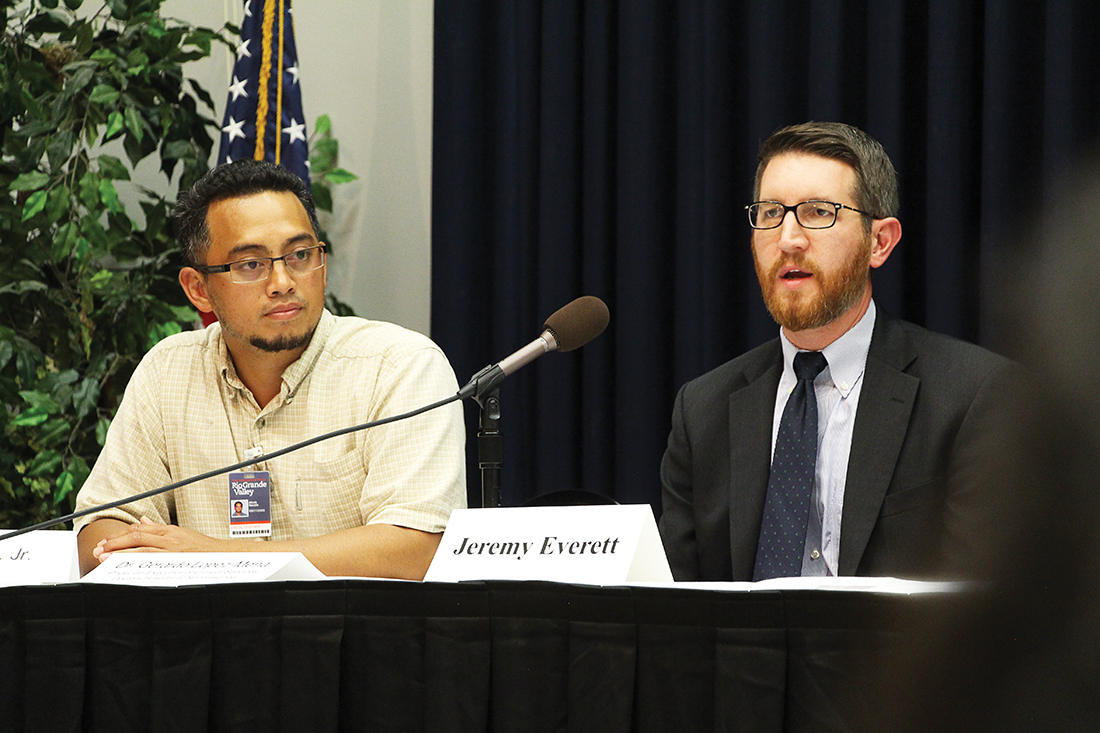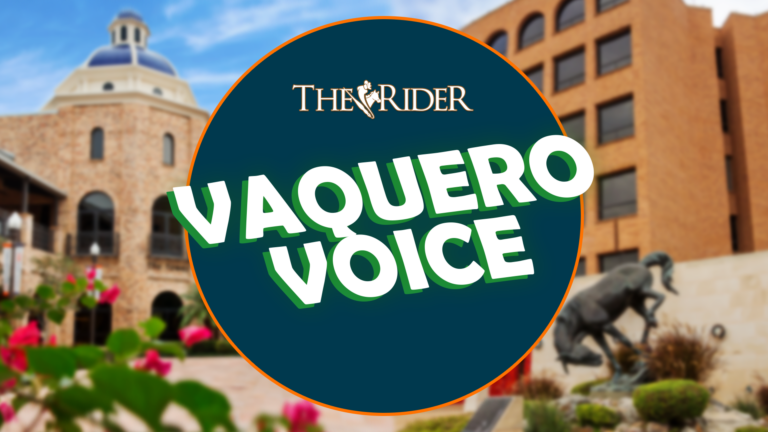
Jeremy Everett, founding director of the Texas Hunger Initiative, speaks during the forum on hunger insecurity last Thursday at the International Trade and Technology building on the Edinburg campus. Also shown is Alex Racelis, Agroecology program director at UTRGV. GABRIEL MATA/ THE RIDER
A Texas A&M University professor and a few social workers are going door-to-door to visit homes in a colonia to assess the living conditions in the community. One social worker asks a woman if she can look into her refrigerator and opens it only to find a single bag of chicken bones there. The woman quietly responded, “This way, when my children open up the refrigerator, they’ll at least see that something is there.”
Guest speaker Jeremy Everett, founder of Baylor University’s Texas Hunger Institute (THI), shared this anecdote at the second annual Food Insecurity Forum that took place Thursday on the Edinburg campus and was livestreamed to Salón Cassia in Brownsville.
A panel of seven community leaders who dedicate their efforts to issues related to hunger, food security and resilient food systems, came together to engage the community to take action. The panelists wished to open a discussion on what needs to be done to address the great disparity between food sustainability, the rapidly growing population and rising poverty rates.
In his opening remarks, Alex Racelis, Agroecology program director at UTRGV, said that in 2014, the Rio Grande Valley became the area with the highest concentration of certified organic farms in the state of Texas, but the region also suffers from the highest rates of food-related health issues and food insecurity.
Within the Biology department, Racelis established a nationally recognized research and student training Agroecology program, which helps students learn how to engage the community of farmers to facilitate sustainability despite urban growth.
Racelis argues that for a region that is surrounded by agricultural wealth, it is sadly ironic that one out of four people in the Valley are food insecure, meaning that they do not have physical, social or economic access to healthy foods.
“If you drive around here you see fields and farms everywhere and yet we have the issues that we have,” Racelis said. “I tell people that we are probably the most disconnected food system in the country because of this. … So, how do we reconnect the food system?”
The panelists actively work in their community to answer this question. Everett has discovered in his travels throughout Texas that by engaging communities, great changes can be made to advance the mission to reduce hunger.
“We’ve seen increase over hundreds of millions of meals for children and their families over the past five years,” Everett said. “So, we’ve seen that these macro-social change theories can work and we know that they can expand access to healthy food for food-insecure families, but we know that we’re not done.”
The panelists discussed what still needs to be done to address this issue, what they are doing to help and how the community can help. Veronica Rosenbaum, Farmer’s Market manager for the Brownsville Wellness Coalition, reported that their hunger initiative has opened five community gardens, two urban farms and La Cocina Alegre,or The Happy Kitchen, to help make healthy food choices more available in low-income communities. They also have a mobile market that rotates between the 10 public housing developments in Brownsville.
“For the first time ever … we have young people being outlived by their parents. [Students] won’t be able to live as long as their parents have. So, there’s something there in stressing the importance of getting involved because we want to reverse those trends quickly.
Jeremy Everett
Founder of Baylor University’s Texas Hunger Institute”
Omar Rodriguez, manager of Communications and Advocacy for the Food Bank of the Rio Grande Valley, boasts that they were able to disburse over 35 million pounds of food through various churches, shelters and food bank locations throughout the Valley, 32 million of which were locally sourced items, meaning food that was produced within the region.
Rodriguez pointed out that where one out of every two children in the Valley are going to sleep hungry, the Food Bank of the Rio Grande Valley is the largest nonprofit at work to reduce hunger in the region.
Belinda Reininger, interim chair for the Department of Population Health and Behavioral Sciences at the UTRGV School of Medicine, argues that the university can help to come together to work and form partnerships that can effect policy change that will prioritize nutrition and affordable access to food resources for the community. She also presented the idea that issues like obesity and diabetes are not often the result of lack of access to healthy food alternatives and lack of affordable resources.
“We know that it’s not just obesity or hunger but it’s obesity and hunger that live simultaneously in the same households, in the same families,” Reininger said. “We’re gonna work together to address this issue. So, for the university, one of the issues we’ve taken on is to bring people together.”
While the event focused on getting down to the business of solving the Valleywide epidemic of hunger and food insecurity, the sincerity of the panelists’ mission was personified when Social Work Department Chair Suderhan Pasupuleti invited two women from the Edinburg Towers public housing development to speak about their experience as recipients of food bank donations. The two women spoke with great pride and gratitude toward the efforts that the food bank has gone to make resources available to low-income families. These residents are now opening their own food bank to serve the needs of their neighborhood.
One of the most telling moments of the night occurred when Racelis remarked that, based on current statistics, this generation of college students will not live to the same age that their parents will, despite all medical and technological advances.
“For the first time ever … we have young people being outlived by their parents,” he said. “[Students] won’t be able to live as long as their parents have. So, there’s something there in stressing the importance of getting involved because we want to reverse those trends quickly.”
To get involved with the initiative to end hunger in the Valley, information can be found at the Food Bank of the Rio Grande Valley website, or the Brownsville Wellness Coalition. More information on the UTRGV Agroecology program can be found on the university website.
The Environmental Awareness Club will also host the UTRGV Farmer’s Market from 11 a.m. to 2 p.m. Wednesday in front of the UREC on the Edinburg campus.






